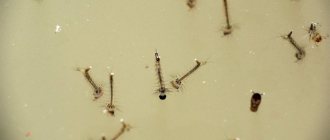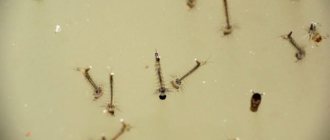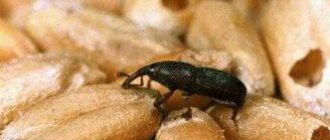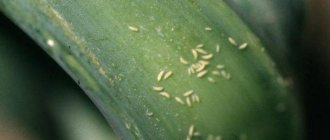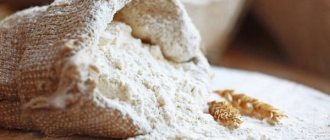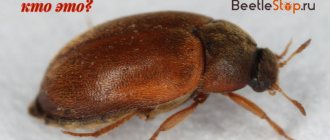The appearance of insects in cereals and flour is a nuisance that many women face. Beetle larvae are very indiscriminate in their food supply and can damage food and even non-food supplies. You should get rid of pests immediately, as they can spoil a large supply of provisions. Their waste products are toxic.
Why do bugs appear in cereals and flour?
Insects, like any living beings, choose their desired habitat and appear in cereals in the kitchen, not because you are a bad housewife and do not keep cleanliness.
They are very small, difficult to notice, and small larvae are practically invisible. Even after sorting through the cereal and destroying all the bugs, there is a high probability of reappearance.
Their eggs cannot be seen with the naked eye; they most often appear from the outside:
- From the store, with new cereals.
- From neighbors, through ventilation or with borrowed flour.
- From packaging containers, etc.
If the bugs are already in your house, then getting them out will be difficult, but doable.
Where do insects come from in cereals?
For a good housewife, there is nothing worse than discovering bugs in purchased cereals. It's especially frustrating when there are a lot of food supplies. Why do bugs appear in cereals, despite daily wet cleaning and keeping the cabinets clean?
Most often, the reason lies in violation of sanitary control at the factory. Improper storage and neglect of the necessary heat treatment of products are factors in the appearance of beetles in cereals. A humid environment promotes their reproduction.
How to get rid of bugs in cereals and in the cupboard?
To understand how to get rid of bugs in cereals, you need to get to know them. After all, in order to fight an uninvited guest, you need to know his habitat, food preferences and lifestyle habits.
For some, changes in temperature or other factors are critical, while others are not afraid of even an atomic explosion.
Here are the types of the most common kitchen pests:
| Name of insects | Description of species |
| Bread grinder | It has a long oval body of red color, 3–5 mm long. Unusually prolific, flies. This ability makes the beetle very difficult to remove. It lives in rice, buckwheat, pearl barley, tea, seasonings, and tobacco. Favorite treat: baked goods |
| Flour beetle | Belongs to the darkling beetle family, length 4–6 mm, oblong body, brown color. Extremely prolific. Lays eggs, camouflaging them with the color of flour. They live in colonies. They live in flour, semolina and oatmeal |
| food moth | A dark butterfly, up to one centimeter long. The discreet color allows for good camouflage. It reproduces incredibly quickly - up to 50 eggs per day. Moth larvae spin webs, making them easy to spot. Not a gourmet, eats everything in the kitchen |
| Red mukoed | Small bugs, up to 2 mm long. Prefers warm and humid places. Lays eggs five to seven times a year. He eats only spoiled cereals. Without the necessary conditions it dies |
| Weevil | Black beetles reaching 5 mm. A distinctive feature is an elongated, trunk-like nose. Omnivorous and unpretentious |
The pests have been identified and the fight can begin. The main thing is to determine what they look like. Photos of cereal beetles are presented on the Internet.
Since beetles live where they like, it is necessary to deprive insects of comfortable conditions.
To do this you will need:
- Remove contaminated food products.
- Do a general cleaning of the premises and rid the house of dampness.
- Purchase special chemical poisonous drugs.
Let's look at the last point in more detail. Insects are the most ancient creatures living on the planet.
The following drugs are offered for retail sale:
- Anti-bug – suitable for all types of insects. Toxic, please read the instructions carefully before handling.
- Karbofos is a universal composition represented by liquid, aerosol, and powder. It will destroy parasites and prevent their reappearance.
- Mashenka is a universal preparation, available in the form of chalk, which is used to smear cabinets and baseboards. Has a repellent effect.
- Fire protection Lovin is an effective remedy. Destroys not only insects, but also their offspring.
Extremely toxic. Used in places inaccessible to children and animals. Please read the instructions in detail before use.
You can use folk remedies that are not at all dangerous to humans, but are effective against parasites.
This will help:
- Radical temperature regime: the infected cereal is placed in the freezer for a day or in the oven for 15 - 20 minutes at a temperature of 115ºC.
- Water with a high concentration of salt. The method works well for legumes.
- Vinegar water. It is used to treat shelves and containers in which bulk materials are stored. The pungent smell of vinegar repels uninvited guests.
- Products with a strong odor. Citrus peels, garlic, dried walnut stems, bay leaves, spices, lavender - strong-smelling aromas irritate the nervous system of insects.
The selected product must be placed in a gauze bag and placed directly into the cereal, making the insects’ habitat unbearable. Borax and boric acid are universal poisonous agents for beetles that destroy, repel and prevent their appearance.
You can make small balls on your own by mixing with sugar, egg or dry yeast.
How to fight and get rid of insects using chemical means
You can get rid of insects in an apartment not only with folk remedies. But chemicals cannot be used to clean cereals, as they pose a danger to humans. Once in the body with food, the toxin can cause acute poisoning, at a minimum.
Insecticides in the form of emulsions and aerosols are sprayed in rooms from which all products have already been removed. The procedure is usually carried out as one of the points in a comprehensive pest persecution plan. After treatment, it is forbidden to stay in the room for some time if it is not ventilated, but food cannot be stored for even longer.
The only substance of this type that is relatively safe for humans is Pyrethrum. The natural insecticide is based on Dalmatian chamomile and is often used to treat indoor plants.
Important: the use of chemicals is carried out exclusively in accordance with the instructions on the packaging.
Are bugs harmful to human health, and is it possible to eat affected cereals?
When pests are found in loose grains, many housewives do not know whether the grains can be eaten. Let's consider this issue in more detail.
If it’s a pity to part with spoiled supplies, then they should be:
- Sift flour through a fine sieve.
- Sort the cereal thoroughly.
The sorted bulk materials are disinfected by calcination in a hot oven at a temperature not lower than 50ºC.
Are pests dangerous to health?
Why are small insects dangerous to health? For an adult in good health, they are not dangerous, it’s just unpleasant to realize that someone is rummaging through the cereal. Another thing is children or people with weak immune systems. They may develop allergies after eating these foods.
Parents do not understand where it comes from in their child, and the cause may be harmful insects.
They can also cause poisoning of the body, which will lead to gastrointestinal upset, even an increase in body temperature.
Before using these products as food, the bugs must be removed. It is more difficult to get rid of their waste products. In this case, more careful processing will be required.
How to store cereals to prevent bugs?
Methods for storing cereals, as well as preventive measures, are quite simple:
- Clean closets and utility rooms regularly.
- Store bulk products only in clean, hermetically sealed containers.
- Do not store large quantities of cereals in one place.
- Conduct weekly control checks for infestation.
- Place purchased cereals and flour in the freezer for disinfection overnight.
- Store long-lasting foods (legumes, nuts, dried fruits) in the refrigerator.
- The room with stored cereals should be well ventilated and have a low level of humidity.
- For prevention, place a clove of garlic or orange zest in a container with cereal.
- Keep it clean, don't litter.
Useful video
Why do bugs appear in cereals, how to get rid of pests and which cereals are most susceptible to their influence? First of all, you need to understand that bugs only appear where there is constant access to food. Insects are attracted to loose materials not only in open containers and bags, but also when scattered on shelves and in cabinets.
Cereals and pasta are a favorite treat not only for bugs, but also for food moths. Insects also actively eat cereals, crackers, dried fruits, bread; they can be found in spices and food concentrates.
Types of bugs
Not only are the beetles fertile and camouflage their eggs, but they also come in many varieties. Insects have different food preferences, living conditions, and reproduction rates. Accordingly, the methods of dealing with them also differ. So, is it really difficult to exterminate them? Let's figure out in order what the different types of bugs are called and why they are interesting. Look at the photos and look for people you know.
Bread grinder
This is a red bug that lives in buns, cereals and tea. He’s a good flyer, but he won’t leave the apartment of his own free will, so the fight with him promises to be long.
Weevil
A black insect with a long proboscis, unpretentious to food and habitat. It flies poorly, but this does not prevent it from moving. The weevil can live for a long time without food, so it is useless to starve it.
Suriname mucoed
A small red bug that lives in spoiled cereals and is not averse to eating sweets. Very prolific, but cannot stand the test of hunger and unusual conditions.
The flour bug lives in oatmeal, semolina and flour
Probably familiar to many - this is a long (up to 4 mm) dark brown creature that spoils oatmeal and semolina cereals and flour. Its eggs also look like white grains, and therefore are not easy to detect.
food moth
In fact, it has several types, and they look different. We have already written about moths and means to combat them.
What bugs are found in the kitchen and how do they get there?
It’s not enough to discover that there are bugs in flour and cereals, damaging products with lightning speed. To choose effective pest control products, you need to clearly know what type they belong to. There are several main types of bugs that damage bulk products:
- bread grinder;
- flour bug;
- red mucous eater;
- food moth.
Bread grinders are miniature light brown bugs that can fly; they most often settle in cereals; they enjoy baked goods, old medicinal herbs, as well as tea and coffee with great pleasure. They enter the apartment with contaminated store products, as well as animal feed.
Flour bugs settle in flour more often than in any other product; they can often be found in bags of starch. Insects simply penetrate boxes in the kitchen with bulk products, including packages of rye, rice flour, rolled oats and semolina. Infrequently, you can see pests in dried fruits, rice or buckwheat.
The peculiarity of insects is the ability to reproduce quickly. Female beetles camouflage their oviposition in crevices of furniture in the kitchen, in cereals, flour, and on cabinet shelves. A new generation of pests quickly spreads throughout the home in search of food sources.
The red common mucoed is no more than 2.5 mm long. It most often enters the premises together with low-quality animal feed. The pest’s favorite food is cereals, grains, flour with an expired shelf life and a moisture content of no more than 15%. In order for the red flour beetle to stop spoiling food and breeding in the kitchen, it is enough to block access to food sources.
The food moth infests in buckwheat, rolled oats, semolina, rice, flour. A mature individual visually resembles a silver butterfly and reaches a length of 10 cm. Its appearance in the kitchen is associated with violation of food storage rules; in addition, the insect enters the house through ventilation holes and open windows.
In addition to the fact that insects are found in semolina, millet and other cereals, in some cases tea and cocoa, dried fruits, and pasta are also infected.
It is not difficult to identify pests in products - they leave behind a thin web woven from small yellow worms.
Types of kitchen parasites
The following pests can appear in the kitchen:
- Bread borer - small (length - 3 mm) light brown insects. They are attracted to book bindings, crushed grain mixtures, coffee, dried herbs, tea, animal feed and dried bakery products (crackers, crackers, cookies, biscuits). The bread grinder flies well - it can fly into a window, guided by the light. But most often, bugs enter the house along with store-bought food and animal feed;
- Weevils are small dark brown or black bugs with a long proboscis. Under favorable conditions, they produce offspring up to 6 times a year. Most often they can be seen in packages with buckwheat, pasta, rice, flour and legumes;
- The flour bug is a small insect (4 mm long) with a red-brown body. These pests are brought into the house along with flour and starch. The flour bug easily penetrates into any container. They happily live in all types of flour, buckwheat, rice, semolina, dried fruits, and rolled oats. These insects reproduce incredibly quickly. Eggs are laid not only in food, but also in the crevices of furniture, as well as in home textiles. Hatched individuals are able to crawl throughout the house in search of food;
- Food moth - the adult resembles a gray butterfly with a body 10 mm long. The reason for its appearance is inadequate processing and storage of food products. Moths can also fly into the kitchen through open windows. Most often it settles in packages of tea, pasta, cocoa and dried fruits. Infected products are covered with a thin cobweb; yellow worms appear in them;
- Red flour beetles are miniature bugs (length - 2.5 mm), the source of infection of which is low-quality grain food for pets. It is a frequent inhabitant of bakeries, mills, and factories. They like to eat grains, cereals and spoiled flour with a moisture content of more than 15%. Unable to find suitable food, the red mucous eater dies.
These photos will help you recognize these bugs.
Attention! If there is a strong infestation of bugs, the nutritional value of the food is reduced to zero. Together with insects, bacteria settle in them, which can lead to allergies and food poisoning.
Preventive measures: how to prevent infection?
To prevent insects in cereals from complicating your life by requiring a number of operations to destroy them, you can follow simple recommendations regarding the prevention of their appearance. These include:
- Warm up the purchased cereals in the oven at low temperature for half an hour.
- Freezing bulk products in the freezer for 24 hours (use dry, ventilated packaging).
- Dried fruits are treated with boiling water, followed by washing and storing exclusively in the refrigerator.
- Thorough inspection of purchased products (including vacuum packaging) with disposal of cereals and flour with signs of contamination.
Bulk materials should be stored in perforated polyethylene or closed glass containers. As an alternative, metal boxes and ecological bags made of natural linen are suitable.
One of the reasons why bugs appear in flour and cereals is failure to comply with the shelf life of products. To avoid creating conditions favorable for pests, it is worth buying cereals and other bulk products, as well as dried fruits, coffee and tea with a minimum supply.
It is believed that rice, semolina, flour and buckwheat can be stored for no more than six months; oatmeal and millet can be stored for no more than 4 months due to their high fat content.
The record holder for shelf life is polished rice. Many varieties become even better after several years of storage, acquiring additional taste.
If you still cannot avoid contamination of food in the kitchen, you can get rid of bugs in cereals, flour and spices in several ways.
Prevention
To prevent insects from appearing in bulk products, you need to follow a number of simple rules:
- Immediately after purchase, store-bought cereals are calcined in the oven for 10-15 minutes, and then scattered into airtight containers with a tight-fitting lid.
- When deciding what to do to prevent pests, you should avoid buying large volumes of products, as they are more difficult to protect.
- Knowing why bugs often appear in cereals, you can prevent its infection by placing a clove of garlic in a container.
- It is better to store food in the refrigerator: dried fruits, cereals, nuts.
- Bay leaves can be used instead of garlic.
Even an experienced and very careful housewife may one day discover illegal inhabitants in her kitchen - small bugs living in dry food supplies. Not only do these insects spoil the taste of food, but even their mere sight is disgusting!
In today's article we will find out why bugs appear in cereals, flour, pasta, dried fruits and starch, whether it is possible to eat affected products, how to remove insects forever and prevent them from appearing in the future.
Recycling is a simple and reliable method
When there is neither the desire nor the ability to fight the increasing population of harmful insects in bulk products in the kitchen, it is worth moving on to a radical method - recycling damaged cereals.
Packages, sacks, containers with bugs are carefully packed in sealed cellophane and taken out of the house.
Places where contaminated products were stored (shelves, cabinets, mezzanines) are thoroughly treated with soda, vinegar or chlorine solution, followed by rinsing with clean water.
General cleaning as a method of pest control
Pests can also be removed by thoroughly cleaning their habitat. But subject to the obligatory condition of disposal of affected products.
What do we have to do:
- Empty the cabinet or shelf of its contents. Clean everything inside with a soapy vinegar solution. Pay special attention to food residues that often spill out in storage areas.
- Pour boiling water over all containers.
- Wash fabric bags in salt water.
- For adult individuals, it is better to use special traps.
Plants with a pungent odor also show good results in the fight against insects. These include mint, lavender, lemon balm and others. Soaking cloth strips in extracts will help prevent a new insect infestation. The main thing is not to forget to update your feeds.
Thermal fighting - what effect does it give?
If there are bugs in the cereal, you can try to remove them by raising the temperature to +50 degrees Celsius. We are talking about treating containers with pests with boiling water or steam. The method is especially effective for removing pests in hard-to-reach places.
To free cereals and other bulk products from insects, you can dry them in the oven at temperatures up to 70 degrees for half an hour, or achieve the result by placing contaminated products in the freezer. Most bugs die at a temperature of -15 degrees Celsius.
After destroying the larvae and bugs from the kitchen cabinets and shelves, it is important not to forget to treat the surfaces, as well as all existing cereals, nuts, and beans. As a result of this treatment, it will be possible to get rid of the remaining insects that will simply float to the surface. However, given that products contaminated with insects are unfit for consumption, it is easier to get rid of them by replenishing supplies with fresh cereals and flour.
Self-removal, methods
The following methods and methods of struggle:
Temperature treatment
Lightly contaminated products should be baked in the oven at a temperature within +110 degrees. Freezing out pests is also effective. In this case, getting rid of insects is done by moving the affected products to the freezer. The cereals containing the bugs are first sifted.
Saline solution
Legumes (peas, beans) can be filled with saline solution. You need to wait until the beetles float to the surface, then you just have to strain the food and dry it on a napkin.
Pyrethrum powder
If pests are found inside cabinets, sprinkle pyrethrum powder on the shelves. This is a natural insecticide that does not have a negative effect on humans, however, with its help, the fight against bugs gives good results.
Use of borax
You need to make bait using this powder, as well as some cereal and powdered sugar.
The product is mixed, then left inside the cabinets on sheets of paper.
Furniture treatment is also necessary, because this is where pests lay eggs. After getting rid of the remnants of scattered cereals, flour and emptying the cabinets of food, you need to treat all surfaces with a vinegar solution. It is prepared in the following ratio: 1 tbsp. l. essences per 1 liter of water. It is recommended to treat the cracks with hot steam or boiling water.
If food is heavily contaminated, it must be thrown away, as the risk of poisoning increases.
Video: Storing cereals correctly to prevent bugs from infesting them
Chemicals in pest control
If there are bugs in the cereal, what should you do when the previous methods above do not give the desired effect? In such cases, it makes sense to use chemicals. The active drugs are Karbafos and Antizhuk. The second has a universal effect, helping to cope not only with kitchen bugs, but also with wood bugs that damage furniture, windows, laminate and parquet. The drug must be used with extreme caution, following the instructions.
Another remedy against pests, Rogneda, is a powerful antiseptic that allows you to dispose of a number of domestic insects, including mucous beetles, weevils, cockroaches and ants.
You can also remove bugs from the kitchen using the drug “Lovin Fire Protection”, which allows you to achieve a quick effect. The product has a high level of toxicity and is used when there are no animals or children at home.
Is it possible to eat this cereal?
If you find cereal that has bugs in it, don’t even think about whether it can be used, but throw it away immediately. Contaminated products contain the remains of chitinous shells, excrement, and various forms of insect development. Bacteria and fungi settle in such cereals and find an environment for development.
The remains of shells covered with bristles are not digested in the digestive tract of humans and can cause irritation and inflammation of the stomach. Guanine and scleroproteins that are part of tick waste are not absorbed by any organism. In grain affected by pests, uric acid is formed in large quantities, which can cause a number of diseases in humans.
If there are bugs in rice, buckwheat, oatmeal or any other cereal, do not use it. Damage to the body is not detected immediately after eating spoiled cereals. The process of undermining is hidden, cumulative and gradual. As a result of such nutrition, amino acid metabolism in the body is disrupted, the number of red blood cells and hemoglobin in the blood decreases, which leads to lethargy, weakness, and sometimes more serious consequences. Therefore, if there are bugs in the cereal, then it is better to get rid of it than to have health problems. The same applies to flour.
Theoretically, flour containing bugs can be used, but is it worth it? No matter how you sift it, there will still be excrement in it. For example, flour damaged by the Moorish booger darkens, acquires an unpleasant odor and becomes unsuitable for use in cooking. If you make dough from such flour, it will not rise well and the bread will turn out low and soggy.
Working folk methods: which ones to choose?
Those who consider chemicals too dangerous and the disposal and destruction of insects by lowering or raising temperatures are not so effective should try to solve the problem with the help of folk remedies. Recipes for some of them are below:
- Table vinegar. All surfaces infected with the bug are treated with a vinegar-based water solution, along with the simultaneous disposal of cereals and flour damaged by pests.
- Bay leaf, pepper, garlic, sulfur. All of these are products whose smell is feared not only by flour bugs (the photo below will prevent you from making mistakes in identifying pests), but by other types of insects.
- Antiseptics of natural origin - chamomile or calendula can also repel pests.
An interesting option that allows you to forget, if not forever, then for a long time, what bugs in cereals are (a photo will help you correctly identify the type of each) is a trap based on boric acid.
Bait works on a simple principle: insects are attracted to the bait. Hungry bugs try a poisoned treat, become infected with toxins and poison the rest of the colony.
To prepare the bait, boric acid is mixed in a container with powdered sugar, semolina, honey, and syrup. Treats will only attract pests if they are fresh. It is recommended to use traps when children and pets are not at home, placing them in insect habitats.
Even the most responsible housewife can encounter insects in her home. No one is immune from purchasing cereals or dried fruits infested with pests. If “uninvited guests” are not eliminated in time, they may even appear on the floor and walls. Find out how to deal with bugs in cereals and how to prevent them from appearing again.
What bugs are found in food?
Suriname mucoeds and weevils (rice and granary) are the most common in the kitchen. Insects do not harm people, but they spoil cereals and flour products. Weevils are dark-colored bugs with an elongated proboscis. In dry and warm conditions they give birth 5-6 times a year. They often eat buckwheat, rice, old flour and pasta, as well as legumes.
If the bugs in the cereal are dark brown or black in color, and you find them in pearl barley, semolina or oatmeal, then most likely you have a Surinamese flour beetle. This insect lives in grain storage areas (warehouses, shops), as well as in apartments and shops. Depending on living conditions, it can produce offspring 2-6 times a year.
Have similar bugs appeared in cereals (photo)? Take immediate action to prevent them from multiplying further.
There are bugs in the kitchen ↑
Reasons for the appearance of “uninvited guests” ↑
Small black bugs in the kitchen can appear due to the dishonesty of manufacturers who did not process the cereal according to all the rules, and as a result of non-compliance with the storage conditions of the purchased product.
Even buying buckwheat or rice in a tightly closed package will not provide a complete guarantee of safety; such cereals can also be contaminated with insects
Bugs can “move” into a container with cereal from neighboring jars on the shelf. Tea, dried fruits, pasta, flour, spices - all this can serve as food for insects.
Main types of kitchen pests ↑
- Small flour beetles
Brown beetles up to 3.5 mm in size bear offspring 4 times a year. Any cereals, flour and starch can be infected with beetles. Khrushchaki make the product lumpy and unsuitable for food.
- Red mukoeaters
Mills and bakeries are common habitats for these insects. Flour eaters end up in the kitchen along with stale flour. The female flour beetle lays eggs in the cracks between shelves and in the folds of packaging bags. The insect reproduces 2-3 times a year, its life expectancy is 3 years. In the photo below you can see beetles in flour - mucoeds.
Mucoed beetles and larvae
- Bread grinders
This 2 to 4 mm long, light or dark brown pest has a more varied diet. Its menu may include: cereals, tea, flour, crackers, cookies, nuts, dried fruits, medicinal plants. When there are too many bugs, they can even be seen on the walls. If you have insects in your kitchen, photos with names will help you identify them.
Pests thrive in humid and warm environments
- Mole
If you find sticky lumps, cobwebs, cocoons or larvae in bulk products, you can talk about moths entering the kitchen. This is what they call flour and granary moths. The moth butterfly does not feed on cereals; it needs the bulk product to lay eggs.
As soon as the caterpillars emerge, they spread throughout the kitchen in search of a place to create a cocoon.
Moths can quickly “take over” the kitchen area. Therefore, start fighting the “enemy” as quickly as possible.
Important! When purchasing cereal, pay attention to the integrity of the packaging and the expiration date of the product. If you have the slightest doubt, refrain from purchasing.
- Pea weevil
The insect is very fond of beans, especially the white variety. The weevil climbs inside the grain, eating away all the nutrients.
To protect beans or peas from grains, dill seeds are placed in bags of legumes.
What is the danger of contaminated products ↑
Many people ask the question: “Is it possible to eat cereals after removing the beetles from them?” Experts do not recommend preparing dishes from products spoiled by pests. During their life, insects leave excrement and shells of larvae in them. In addition, the beetles eat the core of the grains, and the remaining part becomes bitter and acquires an unpleasant odor.
Important! After eating spoiled foods, allergic reactions and stomach upset may occur.
What are bugs?
There are various pests. Flour beetles are widespread in private residential areas; grain grinders and red flour beetles usually live in production areas. If there is damage to dried flour products in the kitchen: crackers, cookies, dryers, it can be argued that they are infested with bread grinders.
Their external characteristics: small size (up to 3 mm), light brown body color, presence of wings.
Bread borers are the most tenacious, prolific, voracious and unpretentious pests.
Such beetles strive for light, for this reason they are often found near windows on windowsills. Favorite food besides dried flour products: tea, coffee, dried medicinal plants, animal feed. Such insects are introduced along with contaminated food, from where they spread throughout the kitchen supplies.
If we consider the red flour beetle, then it is usually found in production: flour mills, cereal factories, bakeries. Such bugs can appear in flour and cereals that show signs of rotting. To avoid contamination of products, they should be stored at low humidity (not higher than 15%). If these recommendations are violated, insects will immediately attack the cereal. External signs of beetles: small size (up to 2.5 mm), red color of the body.
This pest cannot damage dry grain whose moisture content is below 15%.
Flour beetles are common in private housing. This is a red-brown insect whose size ranges from 3 to 4 mm. It is usually brought along with the contaminated product, from where it is distributed in the kitchen among clean cereals. Bugs prefer any flour: rice, wheat, rye. In addition, they settle in semolina and oatmeal. If there is no other food or if there is severe infection, rice, buckwheat, and dried fruits may also suffer in the kitchen.
These insects especially “respect”: flour, rice, buckwheat, semolina, Artek cereals, millet and dried fruits.
It doesn't hurt to know where they live. The most common type - the flour beetle - lays eggs in cereals, crevices of cabinets and other furniture in the kitchen.
Its offspring spread to all places where bulk products are stored. As a result, in a short period of time, all cereals and flour become contaminated.
Do you eat contaminated food?
If there are too many insects, it is a pity to throw away flour, rice, buckwheat and other cereals. This raises the question, is it possible to eat them with bugs? The answer will be negative, since there is a danger of poisoning. In addition, allergic reactions occur in people who eat such food.
Infected flour and cereals completely lose their beneficial properties, as the beetles draw all the nutrients from the grain. Accordingly, the nutritional value of such products is extremely low.
If bugs are infested in large quantities in the cereal, it will not be possible to save it; it is better not to risk it and throw away the product.
Ways to control insects ↑
If small bugs appear in the kitchen, you will have to start a big cleaning and look through all the cabinets, drawers, bread bins and cereal containers. Even if you eliminate visible insects, larvae laid by them may remain in the cracks.
In the warmth of your home, bugs from an infected product will quickly spread throughout the kitchen
- The cereal is heated in the oven for 20 minutes at a temperature of 60°C, and then poured into tightly sealed jars. When the cereal is heated, the beetles will die, but the unpleasant musty smell will still remain in the cereal. In addition, during such processing, vitamins and proteins of the product are lost.
- Health nutrition experts recommend leaving a bag of buckwheat or rice in the freezer for several hours. If the cereal is infected with a pest, the insects will die, but the benefits will remain.
- To get rid of bugs in beans, soak the beans in salt water and then rinse with water several times. The spoiled grains will float to the surface and can be easily separated from the whole and undamaged grains.
- After identifying bugs, wash kitchen cabinets with water and laundry soap; it has disinfecting properties. Then wipe the surfaces with a vinegar solution. The cracks and latches of cabinets can be doused with boiling water.
Tip: insecticides can be used to kill pests in hard-to-reach places (all food products must first be removed from the kitchen).
By keeping your kitchen tidy and clean, you can minimize the risk of insects.
If there are bugs in the kitchen, do not hesitate to get rid of obviously spoiled products - they will not bring any health benefits. Be sure to carry out a set of measures to disinfect cabinets and shelves.
Prevention of black bugs
In order to prevent the appearance of bugs in cereals, observe the following preventive measures:
- Carefully inspect the product when purchasing for the presence of pests and the tightness of the packaging;
- observe the expiration dates of cereals and do not make large purchases in reserve;
- Store products in sealed, separate containers. The ideal option is glass containers that allow light to pass through and protect from moisture;
- periodically audit your supplies and throw away those that are in doubt;
- maintain cleanliness and order in the kitchen, prevent high humidity in the room;
- place pest repellers next to the cereals - garlic, bay leaf, nutmeg;
- Before cooking, check the grains and do not forget to rinse them well.
To store cereals at home, use glass containers with a hermetically sealed lid. This will prevent the appearance and reproduction of pests
You can get rid of bugs in cabinets and in the kitchen yourself, using proven folk remedies and achievements of the chemical industry. At the same time, it is important to get rid of the source of infection, carry out general cleaning in the kitchen and audit supplies. In order to avoid problems in the future, follow preventive measures and pay special attention to the quality of the cereals you buy, their shelf life and storage rules.
Prevention methods ↑
- Do not buy too much cereal, do not store it in plastic or paper bags. A glass or plastic jar with an airtight lid is the most suitable option for storing bulk products.
- Place a pod of dry hot pepper or a couple of cloves of unpeeled garlic in each container of cereal - beetles do not like such smells. Some housewives add crushed clove powder to the cereal and wash the cereal before cooking.
It makes sense to keep dried mushrooms, rose hips, and beans in a vacuum jar for food storage
- Place a linen bag with salt and bay leaf at the bottom of the container. Salt exhibits disinfecting properties and absorbs moisture. You can also use dry lemon peel or chestnut - all this repels insects.
- Food pests do not like metal objects. Place a piece of food foil or a regular metal spoon in jars of bulk products.
- Wipe down your kitchen shelves with vinegar from time to time. Don’t forget to dry the washed cabinets.
- Use sealable glass or plastic containers to store bulk products.
Advice. There are also folk remedies for insect pests. Mix boric acid, powdered sugar and flour in equal proportions. Place the product on the shelves of the closet and in the pantry.
Why are bugs dangerous?
After people notice uninvited guests, most immediately begin to wonder whether this food can be eaten. Some, of course, will not be able to do this psychologically, because they have seen a huge accumulation of parasites. Nevertheless, there are also those who do not mind washing, sorting and cooking the cereal. You can't do this. Even when we managed to get rid of the beetles.
The reason for this is the danger to the human body. It consists of waste from the life of larvae and adults, as well as a sharp decrease in the nutritional value of the product. If parasites are found in pearl barley, then you should not cook it and eat it. This will lead to severe poisoning and an allergic reaction.
The greatest danger is posed by parasites that live in semolina and flour. Their excrement is difficult to distinguish from grains of the product. At the same time, there is a high probability that the grains contain mold, which will increase the negative effect on the body.
If you regularly consume such food, a number of problems will appear. Signs that a person is eating food containing flour parasites are:
- Deterioration of immunity;
- Increased fatigue, drowsiness;
- Apathy, depression;
- Headaches, spasms of internal organs.
If such symptoms appear, it means that worms or adults are caught in the food. The person will need to see a doctor immediately.
Where and in what should you store cereals ↑
One of the reasons for the appearance of brown bugs in the kitchen is a violation of the shelf life of cereals.
- Buckwheat, rice and noodles by weight can be stored for six months, millet grains - 3 months, corn - 4 months.
- Flour can be stored on the shelf for a year, oatmeal - 7 months. Polished basmati rice has a long shelf life of 18 months.
Properly prepared porridge is not only tasty, but also healthy. This statement is true only for high-quality cereals that are not infested with pests.
- Semolina is stored in wooden containers or fabric bags with drawstrings. A glass container is suitable for rice. It is best to store oatmeal in a jar in the refrigerator. Buckwheat is dried in a frying pan and stored in a metal container.
- Nuts and dried fruits should be stored in the refrigerator, not on a cabinet shelf.
- You can also store buckwheat or rice in a linen bag that must be tied. Before use, the bag should be dipped in boiling water with salt (5 tablespoons of salt per 1 liter of water) and dried.
Important! Always throw away expired food items to prevent bugs from infesting your kitchen cabinets.
How do aliens get to us?
Where do these guests come from? Most often they end up in bags in warehouses. There, all bulk products are in open containers. Once you hit one bug, it will quickly lay eggs. And now the bag is inhabited by larvae, from which small insects emerge. Then they move into kitchen cabinets, where they multiply beautifully.
According to technology, manufacturers of packaged products must treat them with a special composition that destroys unnecessary living creatures. But not all workers in this industry carry out processing, so the animals end up in cabinets from bags where bulk products are packaged.
What should you do to avoid bringing these animals into your home? When buying pasta, cereals, flour, pay attention to the following signs:
- Presence of tiny lumps in the package. These could be bugs matted in clumps;
- If the packages have small holes, this is a sure sign of the presence of harmful animals;
- An incomprehensible rustling sound in the product package;
- Rice or buckwheat grains can be eaten. This means that there are bugs in this package;
- There is flour at the bottom of the bag of cereal, which means the bugs are gnawing on the grains, and the remains fall to the bottom.
Video: expert recommendations ↑
Bugs in flour: recognizing the enemy ↑
How to protect supplies from annoying insects ↑
High humidity and high temperature are optimal conditions for the development of any insects. Within a few days, bugs may appear in pest-infested cereals or flour made from larvae. Therefore, if your house or apartment has a dry and cool pantry, it is best to store bulk products there.
Like any material used for window decoration, Roman blinds require care. Before washing Roman blinds, read the information.
How to wash Roman blinds: little tricks for a perfect result
The appearance of such uninvited guests as ants in the apartment does not bring joy - these insects can crawl around the kitchen and get into the most secluded spaces.
How do bugs appear in stores?
- The products were already delivered with beetles from the suppliers' warehouses.
- They have already appeared in the supermarket due to dry air and unsanitary conditions.
So:
- Can't tolerate beetles.
- Bright sunlight.
- Dry air.
- Smells of garlic, cloves, bay leaves.
- Steel materials such as nails or coins.
- Clean and tidy owners.
- High or low temperature.
Need to:
- Carefully select bulk products in stores and markets.
- Keep kitchen cabinets in order.
- Ventilate the premises as often as possible.
- Monitor the condition of the furniture so that no cracks form in it.

